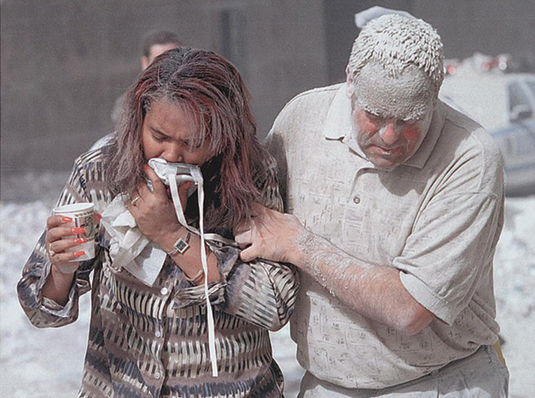
[Continued]
Sitting in a classroom, in battle dress uniform, Air Force veterans blend easily with one another as they listen to instructors and take notes on laptop computers. The soldiers’ personal and medical needs are not identical, though their uniforms seem to match. What makes them similar is their desire for new skills and professional opportunities. It is not easy to see that Staff Sergeant Dave Flowers, pictured left center, has a prosthetic leg under his camo pants. Flowers’ story begins in Afghanistan, where he was part of a team tasked to dispose of a munitions dump. After he stepped on a landmine, he looked down to find that his right leg was gone and his left was shattered.
Flowers admits that he was “computer illiterate” when he began the digital forensics course, but says by the end of the week he was conducting simulations that he can use in his military job.
“We do weapons raids where we might find computers and cellphones,” says Flowers. “If I expand upon information I learned in this class, I could direct people in the field on how to extract information from those devices back on base.”
THE ERA OF AWARENESS
After September 11, Bruce Tatarchuk recalls an intense blip of panic followed by a rush of outside interest in his research area. Tatarchuk, a faculty member in chemical engineering, has been studying air filtration materials for nearly 30 years and says that even with a flood of new interest after 9/11, there haven’t been major scientific breakthroughs since the twin towers fell.
“It changed public awareness about research like ours,” says Tatarchuk. “Suddenly, everyone was talking about WMDs, TICS and TIMS — toxic industrial chemicals and materials — anti-terror technologies, and people wanted to get involved in keeping us safe.”
For Tatarchuk, the best line of defense for a first responder is an efficient filter. Ten years ago, when the haze began to clear, images of first responders caked in dust were hard to bear.
Later, stories began to surface about 9/11 heroes who struggled to breathe during search and rescue, even while wearing masks meant to protect their lungs from hazardous substances.
Tatarchuk’s technology offers protection by using microfibrous materials that catch harmful substances at the molecular level. His research asks the question, “How do you make a filter that stops harmful contaminants?” But it also asks, “How do you dispose of that filter,” “How do you make that filter work in hospitals, schools and homes,” and “How can we make this technology readily available and affordable?”
Treating the cause, rather than the symptoms, is a main focus of Tatarchuk’s work, though no one could have predicted the degree to which first responders and victims would face physical exposure to a highly toxic dust caused by two buildings collapsing.
“We realized [after 9/11] that first responders aren’t just firemen and police,” says Tatarchuk. “So many people rushing to help are civilians, like you and me. They have no training, but also no equipment to protect them.”
During the past 10 years, Tatarchuk’s lab has been busy developing high-efficiency filters that can remove gasses from fuel cell systems and the next generation of gas masks for the U.S. military, but he feels that the more pressing threat to American safety is energy security and healthcare issues associated with breathing unsafe air.
“We need newer and better microfibrous materials now more than ever,” he says. “We need cleaner air that can be filtered for less money. The high energy costs associated with running an inefficient HVAC system are astronomical, but we can solve those problems with new filtration, by cleaning up the air. And those same technologies have anti-terrorism applications.”
PROTECTION OUTSIDE AND IN
James Davidson, faculty member in the Department of Civil Engineering, has been working in the protective structures field since 1996, shortly after the Khobar Towers bombing in Saudi Arabia.
“The Khobar Towers incident demonstrated to the civil engineering community that they must do a better job at designing and constructing buildings that our servicemen live and work in, so they are protected from attacks,” says Davidson.
That terrorist bombing — which killed 19 U.S. servicemen and injured more than 300 others — led Davidson to the Air Force Research Laboratory, U.S. Army Engineer Research and Development Center and the National Science Foundation to work on developing new ways we can remain safe indoors, no matter what is going on outside.
“When an explosion occurs outside of a building, the injuries and deaths are generally not due directly to the explosion,” he adds. “Instead they are caused by secondary effects of the building components that break apart and are propelled at high velocities by the blast shock wave.”
On September 11, 2001, Davidson again wondered how he and other structural engineers could better protect buildings from external explosions.
“It raised two questions about building design and construction,” says Davidson. “Are current U.S. fire codes sufficient, and should we have more robust structural design requirements to prevent progressive collapse, so one failed building component will not result in the instability of an entire structure?”
We know now that the collapse of the twin trade center towers was not due directly to the impact and explosion of an airliner, but as Davidson indicates, by the extreme heat that softened the structural steel frame.
“Once the upper portion of those buildings began to collapse, the remaining structure could not sustain the force,” Davidson adds. “Parts of the Pentagon had been reinforced a few years prior to 9/11, which likely did save lives.”
[miniflickr photoset_id=72157627852275685&sortby=date-posted-asc&per_page=20]